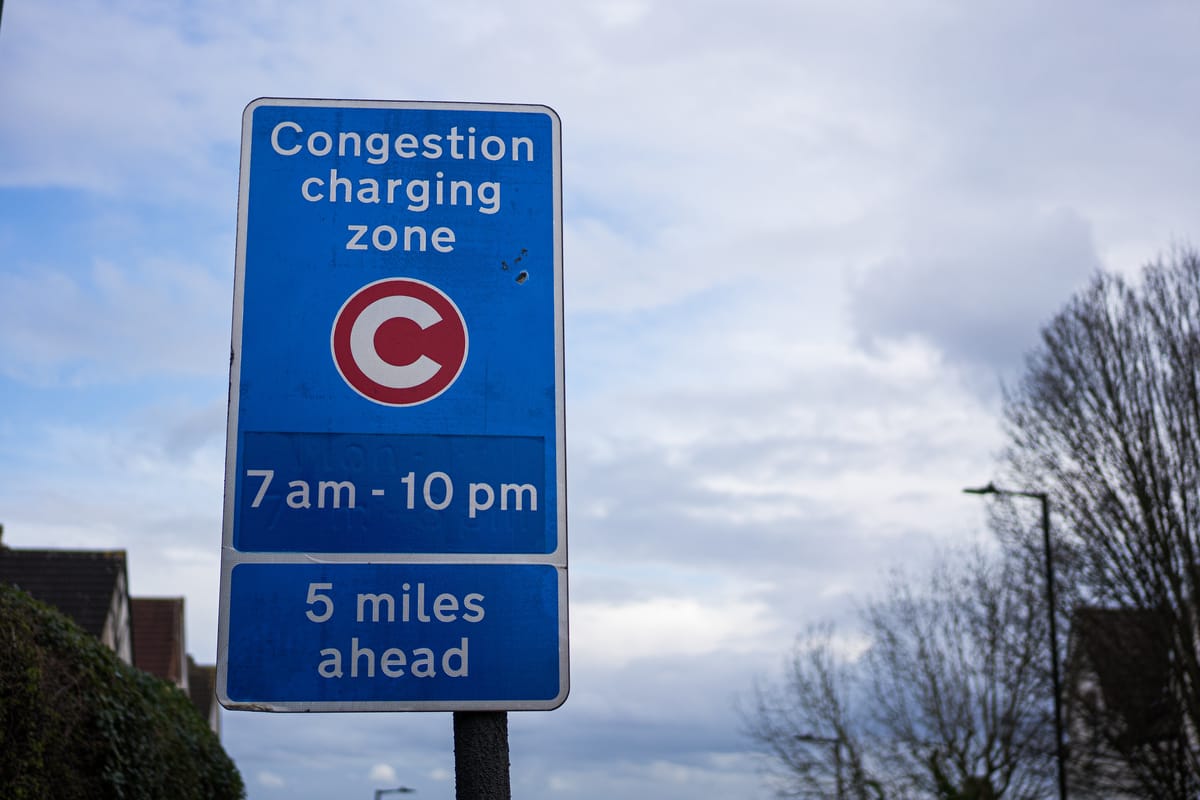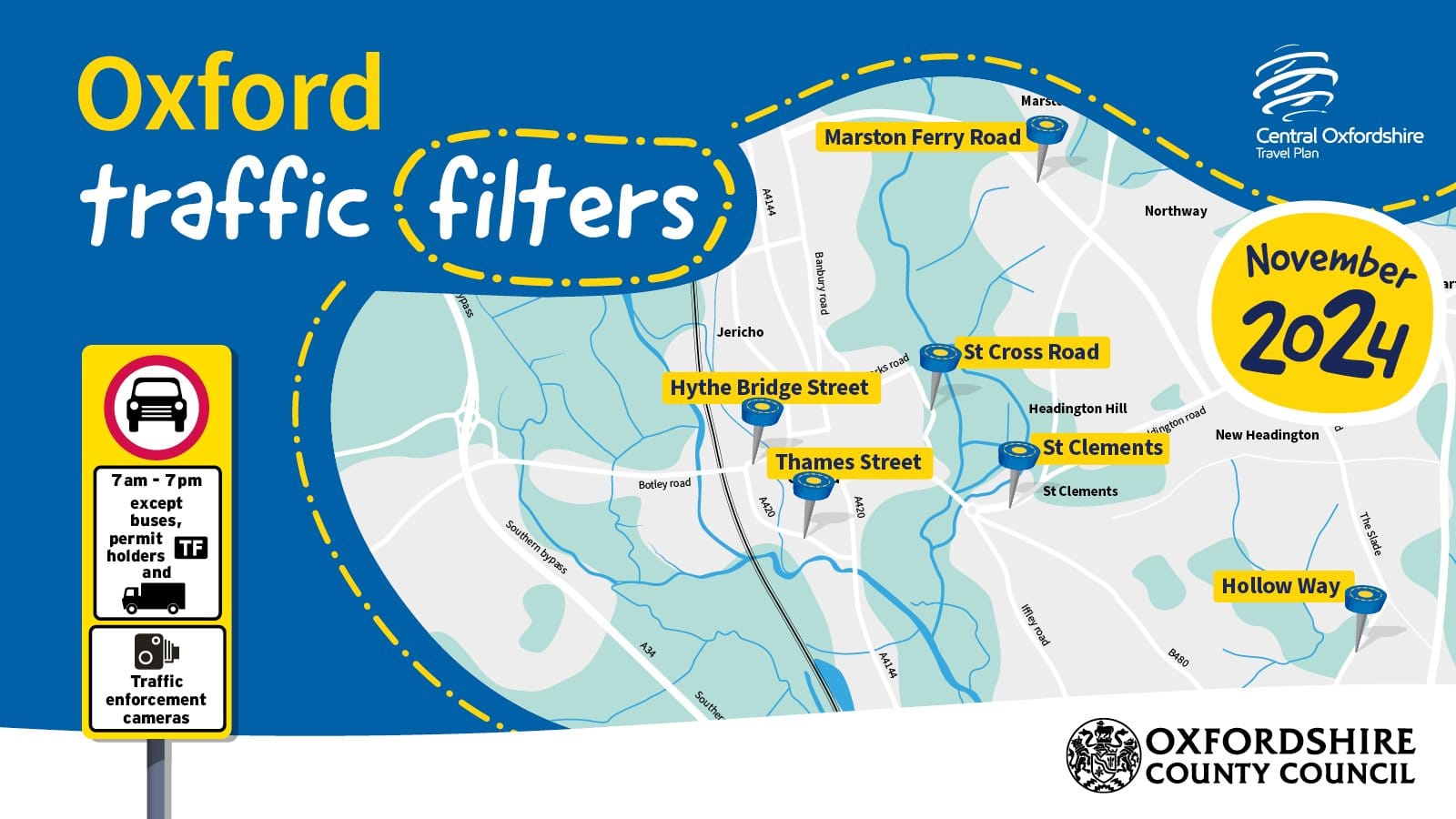Breaking: Oxford congestion charge could start this autumn

Oxford is set to get a congestion charge, with car drivers being charged £5 to pass through the city.
The ‘Plan B’ proposal is Oxfordshire County Council’s response to the ongoing Botley Road rail bridge delays, which have forced the postponement of the city’s planned traffic filters. Bus companies and active travel campaigners have been calling for urgent action to ease congestion.
Under the plans, car drivers would be charged £5 per day to drive past the city’s six traffic cameras – at Hythe Bridge Street (near the station), St Cross Road (city centre), St Clement’s (near the Plain), Thames Street (near the Westgate), Marston Ferry Road (north Oxford) and Hollow Way (east Oxford).
Charges would apply 7am–7pm every day of the week, except Marston Ferry Road and Hollow Way which would be rush hour (7am–9am and 3pm–6pm) on Monday–Saturday only. Payment would be online or by phone.
A congestion charge would use the cameras and technology already lined up for the traffic filters, but operate differently. With a congestion charge, drivers can pass the camera 365 days a year if they like, but will pay £5 per day to do so. Traffic filters would only allow Oxford residents to pass for 100 days (per car) before being fined.
The charge would only apply to cars. Other motor vehicles, including vans, HGVs and coaches, would be exempt. Exemptions (‘permits’) would be on offer for carers, health workers, cars used for business purposes, and blue badge holders, as envisaged for the traffic filters. (Oxfordshire County Council has since confirmed that the 100 free day passes for city residents, and 25 for Oxfordshire residents, would also remain.) In addition, there would be exemptions for those city centre residents and commuters who – thanks to the Botley Road works – currently have no way in or out of the city by car without passing a camera.
Timeline
The draft plans were published today in advance of next week’s County Council cabinet meeting. Assuming the Cabinet approves them, they’ll then be opened to consultation on 23 June, with the intention of bringing in the charge in the autumn.
The Botley Road rail bridge is set to reopen in summer 2026. OCC says that the congestion charge would be “temporary”, and that the traffic filters will be introduced once Botley Road is open again: “This proposal is very much a short-term, temporary solution, making use of existing investment.” But it could decide to stick with the congestion charge if it proves a success, or introduce a hybrid between the two.
Where else has a congestion charge?
Unlike the camera-enforced traffic filters, which are largely untested on a city-wide scale, congestion charging is a well-known system around the world – particularly in historic cities with limited road space. In the UK, both London (£15/day) and Durham (£5/day) have had congestion charges for over 20 years. Other European cities with charges include Milan, Stockholm and Riga.
Most recently, New York City implemented a congestion charge at the start of the year. An analysis by the New York Times (mirror link) concluded the result is “Fewer cars, faster travel, and less honking.” Traffic levels are down by 10–15%, with average speeds at peak hours better by 7.5%. 13% more people are taking the bus, and cycle journeys have increased too. Car crashes are down by 14%. The Financial Times found similarly: buses are faster, fire response times are the best since 2022, and vehicle speeds on the congested bridges/tunnels into Manhattan are up to 20% faster.

(Donald Trump is not a fan of the NYC congestion charge and is attempting to roll it back.)
Back in Oxford, Andrew Gant, OCC’s cabinet member for transport management, said:
“We urgently need to see improvements to travel around the city; better bus services and less traffic overall, to help people get around. We must take action for our residents, businesses and visitors while Botley Road remains closed and I look forward to discussing the options with cabinet colleagues.”
A compromise – or an improvement?
Is this simply settling for second best, or could a congestion charge be better than traffic filters in some ways? Here’s our quick take.
- One advantage is that a congestion charge is simpler. You drive past a camera, you pay £5. That’s it. With misinformation rife about Oxford’s traffic filters, there’s much to be said for a simple scheme.
- It’s more proven. Oxford’s congestion charge won’t be the same as London’s, but 20 years in Britain’s capital city means that people understand the concept.
- But this scheme might not be simpler after all. All the exemptions proposed for the traffic filters will still apply – exemptions that other congestion charges don’t have.
- Is it less equal? Perhaps. A daily £5 charge may not trouble the wealthy owner of a £150,000 SUV. But then the traffic filters already baked in an advantage to those with the money to run 2 or 3 cars, with 100 day passes per car.
- The effect on congestion is the big unknown. Oxford’s traffic filters were forecast to cut city centre traffic by 20%. Will a congestion charge match that? London claims an 18% reduction and New York a little less. Because traffic generally operates at or around capacity, even a small reduction can greatly speed journey times. But all the traffic modelling in the world can’t fully predict human behaviour. The truth is we won’t know until it’s tried.
- Will buses be the big winner? Could well be. London bus travel went up by 33%. Buses would benefit twice over: partly from reduced congestion, partly from more passengers – especially on Park & Ride services. Could OCC be tempted to introduce free P&R parking to coincide with the congestion charge?
- What about cycling? Cycle to work and save yourself £5 a day. It’s a compellingly simple logic: effectively, there’s always a financial incentive to cycle. This is particularly true for Oxford residents, whose short journeys are ideally suited to cycling. But this only works if the congestion charge cuts traffic levels: Oxford’s busy roads and dangerous junctions currently dissuade many from cycling. Is a £5 saving enough for you to brave the Plain?
- Will this sway the doubters? Certainly not all of them. The Independent Oxford Alliance, “Oxford Business Action Group” et al are set against any restrictions on driving – their guiding spirit Jeremy Mogford continued fulminating against the existing High Street bus gate long after the rest of the city got used to it. On the other hand, one IOA candidate was open to “a peak-time-only congestion charge”; the recent Citizens’ Assembly called for “an inclusive but car-free city centre”; a small but vocal online contingent has long argued that a congestion charge would work better; and Labour’s rejection of the traffic filters doesn’t preclude them having an open mind on a congestion charge.
Wrinkling out the arguments for and against is the purpose of the consultation period, expected to start later this month. Ultimately, our crystal ball is clouded right now – the effect of any charge on Oxford’s traffic is too complex to predict. But perhaps, just perhaps, the evidence from congestion charges elsewhere makes them a little less of an unknown.
FAQs
- What’s the difference from traffic filters? The traffic filters would see anyone who drives past the cameras fined £70, with ‘day passes’ to give Oxford residents 100 free days and Oxfordshire residents 25. With a congestion charge, after those 100 days, you can drive through as often as you like but you pay £5 for each day you do.
- Is this like the London congestion charge? Sort of. The London charge applies to anyone who drives into central London, enforced by hundreds of cameras. The Oxford charge will only apply if you pass one of the six cameras. Almost everywhere in Oxford is accessible without passing a camera, but you may need to go via the ring road.
- Where does the £5 go to? Legally, income from congestion charges must go to running costs and other transport projects. In Oxford, this would principally be buses – whether discounting bus fares or sponsoring new services. OCC has raised the possibility of “free or discounted parking at Park & Ride sites”, which was a long-time ask of local Conservatives until a U-turn earlier this year. Any surplus could be used on other transport schemes.
- Where will the cameras be? Same place as the traffic filters would be – see the map below. Again, it means you can get from the ring road to anywhere in Oxford without passing a camera, except for the area around the station, thanks to the Botley Road closure. “Residents, visitors and commuters” to this area will be exempted.

- Wait. Doesn’t that area include the Westgate car park? Well spotted. But (whisper it) if you’re already choosing to pay £25 to a private shopping centre owner for 6+ hours’ parking, rather than taking the Park & Ride for £4, is an extra £5 such a big deal? Answers on a postcard.
